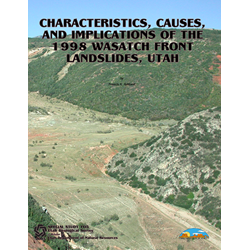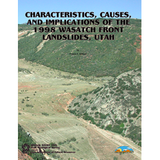Characteristics, causes, and implications of the 1998 Wasatch Front landslides (SS-105)
By: F. X. Ashland
The majority of the 1998 Wasatch Front landslides were likely triggered following a cumulative rise in ground-water levels resulting from four or more successive years of above-normal precipitation. Triggering of landslide movement likely coincided with a transient ground-water-level rise associated with the spring snowmelt and contemporaneous above-normal precipitation. In most Wasatch Front areas, 1998 was the wettest as well as the last year of the precipitation period. An increase in landslide activity began in 1997, following two to four successive years of above-normal precipitation.
This study examines the relation between the 1998 landslides and the 1995-98 precipitation period (1993-98 in Spanish Fork Canyon). Accordingly, this study investigates the significance of the most recent precipitation period in relation to the historical precipitation record, and compares it with the 1980-86 period. In addition, other causes of the 1998 landsliding are explored, most importantly hillside modification related to residential development. This study also examines several issues, and their implications, related to the 1998 Wasatch Front landslides including the susceptibility to reactivation of pre-existing landslides, consideration of the state of landslide activity, and the possibility of developing landslide-movement prediction tools based on an instability threshold concept. The majority of the landslides discussed occurred near urbanized areas of the Wasatch Front and consisted of either translational or rotational earth slides in pre-existing landslide areas. The discussion and conclusions are limited to these landslides and locations. The case histories presented provide new data intended to further the understanding of landslide hazards in the Wasatch Front.
Other Information:
Published: 2003
Pages: 49 p.
Location: Davis, Salt Lake, Utah, and Weber Counties
Media Type: Paper Publication







